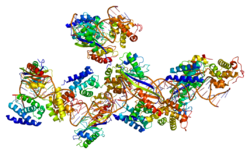There are six steps in the mechanism of TFIIB action in the formation of the PIC and transcription initiation: [14]
Open and closed complexes
The open and closed conformations refer to the state of the DNA and whether the template strand has been separated from the non-template strand within the PIC. The place at which the DNA opens to form the bubble lies above a tunnel that is lined by the B-core, B-linker and B-reader as well as parts of RNA polymerase II. The B linker is found directly aligned with the point at which the DNA opens [18] and in the open complex it is found between the two DNA strands, suggesting that it has a role in promoter melting, but it does not have a role in the catalytic RNA synthesis. Although TFIIB keeps a similar structure in both conformations some of the intramolecular interactions between the core and the B reader are disrupted upon DNA opening.
After DNA melting the transcription initiator (Inr) must be located on the DNA so the TSS can be identified by the RNA polymerase II and transcription can begin. This is done by passing the DNA through the 'template tunnel' and the DNA is scanned, looking for the Inr and placing it in a position that ensures the transcription start site is located in the correct place by the RNA polymerase active site. The B reader of TFIIB is found in the template tunnel and is important in locating the Inr, mutations in the B reader cause the TSS to change and therefore incorrect transcription to occur [19] (although PIC formation and DNA melting still take place). Yeast are a particularly good example of this alignment as the yeast Inr motif has a strictly conserved A residue at position 28 and in the open complex model a complementary T residue can be found in the B reader helix. When this T residue is mutated, transcription was significantly less effective emphasizing the role of the B reader. [14]
The B reader loop is further thought to stabilise NTPs in the active site and, due to its flexibility, allow the nucleic acids to remain in contact during the early synthesis of the RNA molecule (i.e. stabilises the growing RNA-DNA hybrid)





